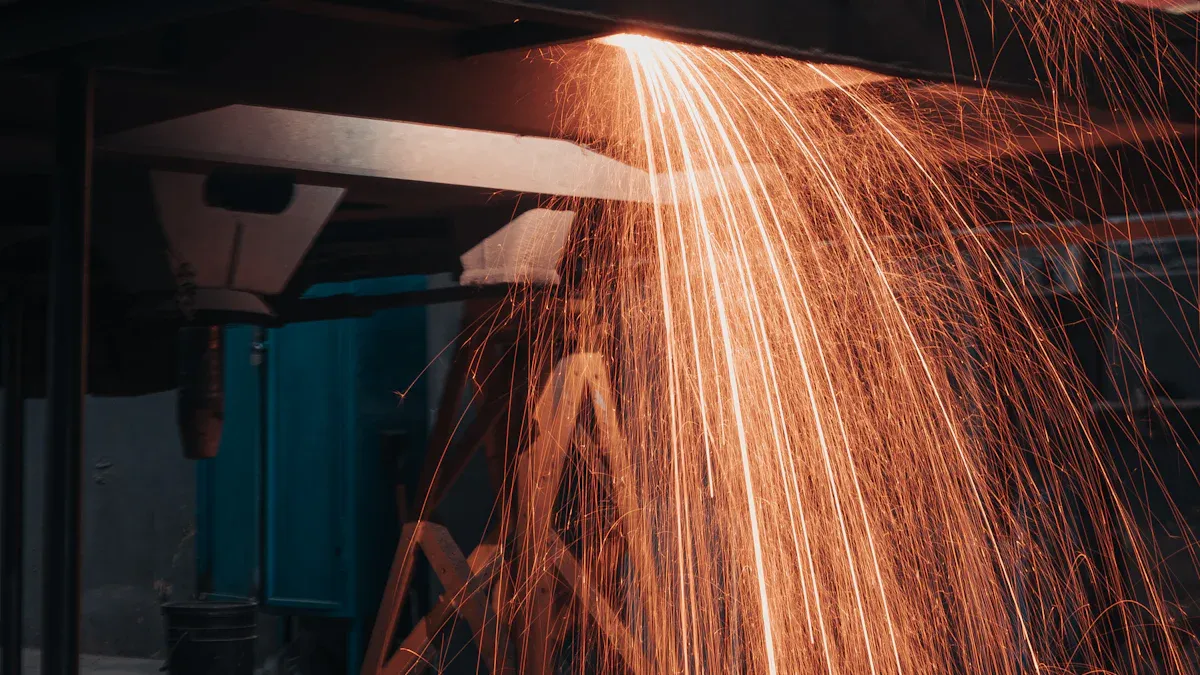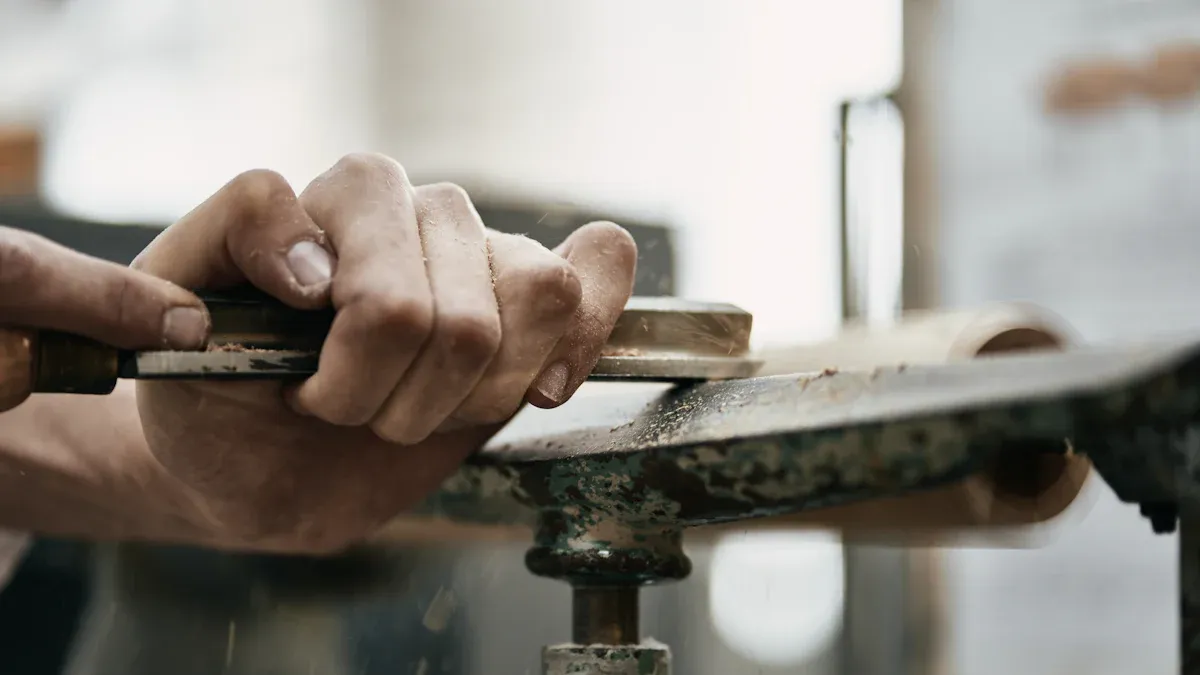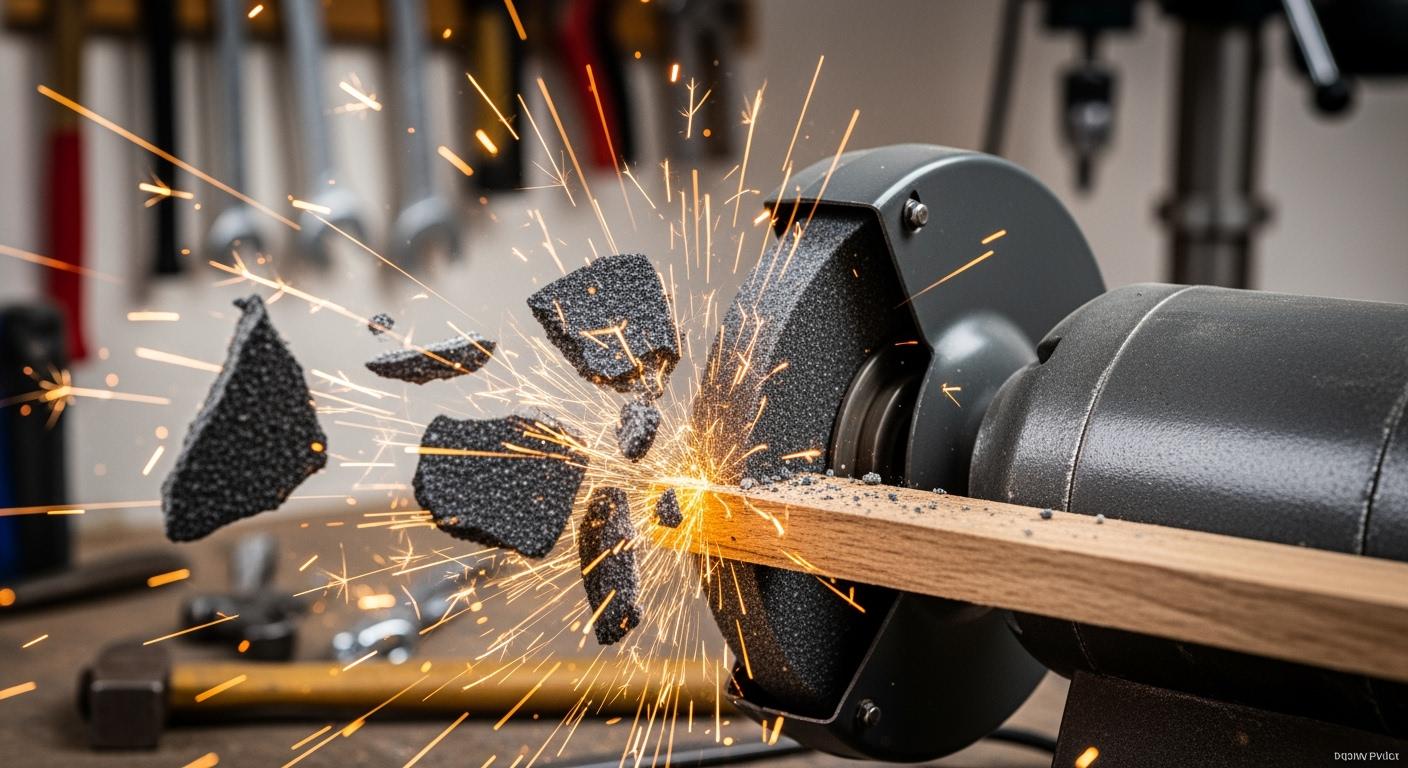You must never use a conventional wheel for grinding certain materials. These include soft non-ferrous metals like aluminum and copper. You should also avoid grinding wood, plastic, or rubber. Using a standard grinding wheel on soft materials causes clogging. This clogging leads to dangerous heat buildup. Your grinding wheel can shatter violently. This guide is an essential tool for your safety. Grinding soft metals like aluminum creates serious risks. Misusing a grinding wheel leads to thousands of injuries each year.
Grinding soft materials like wood, plastic, or aluminum on the wrong grinding wheel can cause it to explode. This sends fragments flying, which can cause disfigurement or permanent disability. Your personal safety depends on using the correct grinding wheel for every job.
Key Takeaways
- Never use a standard grinding wheel on soft materials like aluminum, wood, or plastic. These materials clog the wheel and can cause it to shatter.
- Grinding soft metals like aluminum creates dangerous heat and can even cause fires or explosions due to flammable dust.
- Grinding lead is very dangerous. It creates toxic dust that can cause serious health problems like lead poisoning.
- For hard materials like tungsten carbide or ceramics, a standard wheel will not work. You need special diamond grinding wheels for these jobs.
- Always use the correct grinding wheel for your material. This keeps you safe and helps you do the job well.
Why Soft Metals Clog a Conventional Wheel

A conventional wheel works by using hard abrasive grains to chip away at hard material. However, this grinding process fails with soft materials. The friction from the grinding wheel generates immense heat. This heat melts soft metals, wood, and plastic. These sticky materials do not form chips. Instead, they smear across the abrasive surface. This process is called “wheel loading.” Scientifically, wheel loading happens when separated chips get stuck in the porous spaces between the abrasive grains.
Once the grinding wheel is clogged, it stops cutting. It begins to rub against your workpiece. This rubbing creates even more friction and intense heat buildup. This starts a dangerous chain reaction. The trapped heat can cause the wheel’s bonding agent to fail. The grinding wheel can expand unevenly, lose its balance, and shatter violently. You must understand this risk to ensure your safety.
The Dangers of Grinding Aluminum
Grinding aluminum is extremely hazardous with a standard grinding wheel. Aluminum has a low melting point. The heat from the grinding process quickly turns solid aluminum into a gummy paste. This paste instantly clogs the wheel’s pores. This creates a dangerous situation for several reasons:
- Reduced Cutting Action: The clogged surface of the grinding wheel rubs the aluminum instead of cutting it. This generates more friction and more heat.
- Extreme Heat Buildup: The smeared aluminum acts as an insulator. It traps heat inside the grinding wheel, causing its temperature to rise to critical levels.
- Catastrophic Failure: This extreme heat can destroy the bonding agent holding the grinding wheel together. A loaded grinding wheel can crack from the heat, and the centrifugal force will cause it to shatter.
A user once described seeing a grinding wheel turn into a “grenade” during a severe catch. He said, “I have seen grinding wheels quite literally explode… I got hit in the face from a piece of shrapnel and I was 15 feet away from it.”
Worse yet, fine aluminum dust is highly flammable. One documented incident reported a fireball explosion from grinding aluminum. The fine aluminum dust mixed with steel dust, creating a thermite reaction that burned at approximately 6300°F. Never attempt grinding aluminum with a conventional wheel. The risk of a damaged wheel or a fire is too high.
Issues with Copper, Brass, and Lead
Other soft, non-ferrous metals present similar dangers. Copper and its alloys like brass are very malleable. This property means they deform and smear easily under pressure. When you try grinding copper or brass, the material adheres to the grinding wheel instead of being cut away. This leads to the same loading and heat problems seen with aluminum. The poor machinability of copper makes it one of the most common clogging materials.
While copper and brass pose a physical hazard, lead introduces a severe health hazard. Grinding lead creates fine, toxic dust. Inhaling these particles is a primary route of exposure and can lead to lead poisoning. Airborne lead is often invisible, and you can easily breathe it in.
- Short-Term Effects: Exposure to lead dust can cause headaches, stomach pain, irritability, and nausea.
- Long-Term Effects: Chronic exposure to lead can result in permanent kidney damage, muscle and joint soreness, infertility, and high blood pressure.
Lead is especially dangerous for children and pregnant women. The toxic effects of lead can harm nearly every organ in your body. You should never perform a grinding process on any material that might contain lead. The risk of lead poisoning is not worth it.
Grinding Wood, Plastic, and Rubber
You should also never use a conventional wheel for grinding non-metallic materials like wood, plastic, or rubber. These soft materials create unique and serious dangers.
Grinding wood produces fine dust that is highly combustible. When this dust is suspended in the air, it can ignite from a single spark from the grinding process, causing a flash fire or a powerful explosion. For a dust explosion to happen, you only need five things at once: fuel (wood dust), oxygen, an ignition source, dust dispersion, and confinement. A small workshop can provide all five.
| Wood Type | Minimum Ignition Temperature |
|---|---|
| Pine dust | 450 °C (842 °F) |
| Spruce dust | 490–500 °C (914-932 °F) |
| Alder dust | 490–500 °C (914-932 °F) |
Grinding plastic is just as dangerous. The heat from the grinding wheel will instantly melt the plastic. The molten plastic will coat and ruin your grinding wheel, creating a severely damaged wheel. More importantly, grinding plastic releases toxic fumes. Inhaling these fumes can cause serious respiratory issues and other health problems.
Finally, soft materials like rubber also smear instead of chipping. The rubber particles get stuck in the grinding wheel, causing it to load up. This loading prevents the wheel from cutting, which generates extreme friction and heat. The trapped heat can cause the wheel’s bonding agent to break down, leading to the wheel becoming unbalanced or shattering. The risk of fire is also high, as fine rubber dust is flammable.
Grinding Hard Metals: When Your Wheel Fails
Using a conventional wheel on extremely hard materials presents a different kind of failure. Instead of loading, your wheel experiences “glazing.” Glazing occurs when the abrasive grains on your grinding wheel become dull. They stop cutting and start rubbing, creating a smooth, shiny surface on the wheel. This generates intense heat and leads to poor grinding results.
| Feature | Glazing | Loading |
|---|---|---|
| Appearance | Smooth, shiny surface | Material embedded in pores |
| Primary Effect | Reduced cutting ability | Obstructed abrasive action |
| Key Causes | Grinding material is too hard for the wheel | Grinding soft, gummy material |
Hardened Steel and Tool Steels
You should not use a standard aluminum oxide grinding wheel for hardened tool steels. The grinding process will be slow and ineffective. The hard steel dulls the aluminum oxide grains quickly. This rubbing action generates excessive heat. This heat can cause severe thermal damage to your tool, including:
- Rehardening burn
- Temper burn
- Residual stresses
This damage can ruin the temper of the steel, making it brittle. A tool with grinding damage can easily chip or break during use.
The Challenge of Tungsten Carbide
Tungsten carbide is an exceptionally hard material. On the Mohs hardness scale, it is just as hard as the aluminum oxide used in a standard grinding wheel.
| Material | Mohs Hardness |
|---|---|
| Aluminum Oxide | 9 |
| Tungsten Carbide | 8.5 – 9 |
Attempting to perform a grinding process on tungsten carbide with a standard wheel is like trying to cut a diamond with glass. The wheel will not cut effectively. Instead, it will wear down rapidly while creating dangerous levels of heat.
Grinding Ceramics and Glass
Grinding glass or ceramics with a standard wheel is a recipe for disaster. These materials are brittle and cannot handle rapid temperature changes. The friction and heat from the grinding will cause thermal shock, leading to cracks and chipping. You will end up with a damaged wheel and a ruined workpiece.
⚠️ Health Warning: The grinding of glass and ceramics creates fine crystalline silica dust. Inhaling this dust is extremely dangerous. It can cause incurable lung diseases like silicosis, lung cancer, and COPD. Your health depends on avoiding this exposure.
Safe Alternatives to a Standard Grinding Wheel

Using the wrong grinding wheel is a serious mistake. You must match your tool to your material for both safety and efficiency. Fortunately, manufacturers produce specialized wheels and attachments for almost every job. You can achieve excellent results when you use the correct abrasive.
Wheels for Soft Non-Ferrous Metals
You should never use a standard grinding wheel on soft metals. Instead, you need a wheel designed specifically to prevent loading. The best choice for grinding aluminum, brass, and copper is a silicon carbide grinding wheel. These wheels often contain a proprietary blend of aluminum oxide and silicon carbide abrasive grains. This special composition allows for grinding with less pressure, which keeps temperatures low and stops the material from smearing.
Many brands offer wheels with a “non-loading” bond. These are engineered solutions for soft, non-ferrous metals. The soft bond in the grinding wheel breaks down during use. This action exposes fresh, sharp abrasive grains. This process prevents clogging and ensures the grinding wheel keeps cutting effectively.
Pro Tip: When working with soft metals, look for wheels labeled for aluminum or non-ferrous use. These specialized tools offer several key benefits:
- They are gentle and easy to use for cleaning surfaces.
- They will not gouge, mark, or scratch your workpiece.
- They are designed for aggressive material removal without loading up.
Using the correct grinding wheel for soft metals protects your equipment and ensures your personal safety.
Correct Tools for Wood and Plastic
You must avoid using a standard grinding wheel for wood or plastic. The high speed and hard abrasive are not suitable for these soft materials. For shaping wood, you have much safer and more effective options that attach to your grinder.
Flap discs are an excellent choice for working with wood. These attachments use aluminum oxide grits and are very effective for woodworking tasks. You should start with a coarse grit for heavy shaping. You can then switch to finer grits, like 120 or higher, for a smooth final finish on your wood project. Other useful attachments for wood include:
- Fiber-backed Sanding Discs: Great for quickly removing wood.
- Hook and Loop Discs: Allow you to easily switch between different sanding grits.
- Bristle Discs: Work like a wire wheel and offer long durability for cleaning and stripping wood.
Grinding plastic is extremely hazardous due to melting and toxic fumes. You should avoid grinding plastic whenever possible. If you must shape or clean plastic, use a low-speed tool with a sanding attachment. A standard grinding wheel will instantly melt the plastic, ruining the wheel and creating a dangerous situation. Always work in a well-ventilated area when sanding any type of plastic. Your safety depends on avoiding the risks associated with grinding soft materials like wood and plastic.
Aimgrind Solutions for Hard Materials
Grinding extremely hard materials like tungsten carbide or ceramics requires a tool that is even harder. This is where a standard grinding wheel fails completely. For these tough applications, you need a specialized abrasive solution. Aimgrind is a brand focused on providing customized grinding wheels for challenging materials. With decades of experience, they help you find the perfect match for your equipment and process.
For professionals grinding tungsten carbide, ceramics, and other brittle materials, Aimgrind’s diamond grinding wheels are the superior choice. A diamond grinding wheel uses synthetic diamond grit, one of the hardest materials known. This composition provides incredible benefits.
- Superior Durability: The exceptional hardness of diamond means the grinding wheel wears down very slowly. This gives it a long service life and reduces downtime.
- Unmatched Precision: Diamond grinding wheels maintain their shape and sharpness. This allows for high-accuracy grinding and excellent surface finishes, which is critical in demanding industries.
- High Efficiency: These wheels cut hard materials quickly and generate less heat. This protects your workpiece from thermal damage.
Investing in a high-quality diamond grinding wheel is a cost-effective decision for any serious fabrication work. The precision and longevity they offer enhance productivity and ensure top-quality results. When you need to grind with passion and achieve with aim, choosing the right tool is the first step.
⚙️ You can explore the full range of high-performance abrasive solutions and learn more about Aimgrind’s diamond grinding wheels on their product page.
Remember the single most important rule. You must never use a standard grinding wheel on soft non-ferrous metals, wood, or plastic. Grinding these soft materials causes “loading.” This clogs the wheel, leading to dangerous overheating and potential shattering.
Your safety is non-negotiable. Always verify your material and select the correct abrasive for the job. Using the right tool, like a specialized wheel from experts like Aimgrind instead of a conventional wheel, is essential for tough jobs. Never use a standard grinding wheel on soft materials like wood and plastic.
FAQ
What is the biggest danger of using the wrong grinding wheel?
The biggest danger is “loading.” Soft material clogs the grinding wheel. This causes extreme heat. The heat can make your grinding wheel shatter violently. Using the correct grinding wheel for each job is essential for your safety. A damaged grinding wheel is a serious hazard.
Can I use a wire wheel on my grinder for aluminum?
A wire wheel is a safer option than a standard grinding wheel for cleaning aluminum. It will not load up like a conventional grinding wheel. You should still wear full personal protective equipment. The grinding process can still throw sharp wire bristles from the wheel.
How do I know if my grinding wheel is loaded?
You can see that your grinding wheel is loaded. The pores of the grinding wheel will look clogged with shiny metal. The grinding wheel will also stop cutting effectively. It will rub and burn the material instead of grinding it away.
Why can’t I use a regular grinding wheel for hard steel?
A regular grinding wheel is too soft for hardened steel. The abrasive grains on the grinding wheel become dull quickly. This causes “glazing.” The grinding wheel stops cutting and creates intense heat. This heat can ruin your tool’s temper, making it brittle and unsafe.
See Also
Exploring Grinding Wheel Varieties and Their Real-World Industrial Uses
Selecting Optimal Bench Grinding Wheel Materials for Specific Requirements
Identifying the Premier Grinding Wheel for Your Carbide Tooling
Discovering the Most Effective Grinding Wheel Dresser for Your Workshop
Guidance on Picking the Ideal Grinding Wheel for Stainless Steel
Contact Us
For More Grinding Solution or Customized Abrasive Tools

